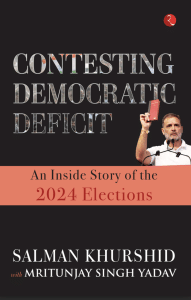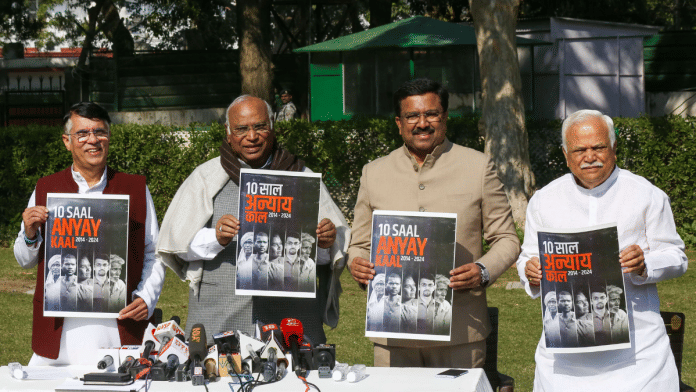The 2014 general election was a watershed in modern Indian politics, sweeping away the decades of dominance by the Indian National Congress.
The arrival of Prime Minister Narendra Modi was to change the ideological content of politics and the style of administration. Two versions of India emerged very quickly—one in the government that sought to reclaim the cultural edifice from illegitimate occupiers and the second in the alternative idea of an India committed to an inclusive character and a liberal intellectual ethos.
Curiously, many political entities and their allies had worked to undermine the Congress United Progressive Alliance (UPA) government, compounded by a series of adverse judicial decisions that unravelled accomplishments in several sectors, like coal mining and telecom.
The BJP’s concerted political attacks and complete non-cooperation on several fronts of political functioning led to the narrative of policy paralysis and corruption. The 2004 dream team returned to power in 2009 but was severely damaged and fatigued. Unrelenting assault by a combination of populism by India Against Corruption, with clandestine support from Rashtriya Swayamsevak Sangh (RSS) cadres, sapped all energy from the party. Defeat came inevitably. While the then Opposition sought to undermine the accomplishments of the UPA, the public at large remained ambiguous about economic reform and refused to be weaned off the state-controlled economy and its comforts. The Ram Temple movement continued to gather steam, and the so-called Hindutva feeling continued to grow. The year 2019 gave the BJP and Modi electoral approval for a second term and the Congress considerable anxiety over what was described by some as a permanent change in India’s thinking, making the BJP the largest political party in the democratic world and the putative natural ruling party. Despite the BJP’s remarkable success, the test of a nation’s success, however, should ultimately be in the total gross happiness of its people, even if there is no mathematical model to measure it.
Of course, this is a sum of comfort felt in personal safety and security, satisfying employment or occupation, housing and educational opportunity. Along with creature comforts, a general and collective sense of wellbeing contribute to a nation’s happiness. Above all, a divided nation or community cannot claim to be happy because the life of a nation lies in its collective growth. The decade of Modi’s India was anything but happy despite the glamorous display of achievements. The Congress and its partners in the Opposition have a take on the last ten years that varies dramatically from the self-certification of unbounded success that the incumbent government gives itself.
Also read: Kohli is the last superstar of Indian cricket. His impact on the game goes beyond 22 yards
Curiously, while the INDIA Alliance underscores the end of the undeclared emergency of the last few years, the BJP continues to harp on the ‘emergency mindset’ of the Congress, despite the long history of electoral victories of the Congress, including the defeat of the Janata government in 1980, and the fact that many parties that lined up against the Congress then are its partners now.
One need not be apologetic for the Emergency or allow it to cast a shadow over our present combative stance against the perversion of democratic rights. The Emergency was declared in extreme circumstances of civil unrest that went far beyond civil disobedience.
The people of India rejected the Emergency in 1977, but eighteen months later gave Indira Gandhi a thumping majority. Since then, several election victories should have settled the issue. The concern now is the undeclared emergency that subverts liberty in a virulent disobedience’s form.
In her 2024 interim budget speech on 1 February, Finance Minister Nirmala Sitharaman confidently emphasized the government’s achievements and announced that the government would lay a White Paper on the House table ‘to look at where we were then till 2014 and where we are now, only for the purpose of drawing lessons from the mismanagement of those years.’
In response, the Congress party was quick to act. The announcement of a ‘Black Paper’ on the ten years of the Modi government was swiftly made.
A dedicated team, including Amitabh Dubey, Varun Santosh and others, began working on a war footing to prepare the document within an incredibly tight deadline of less than seven days. Fortunately, some groundwork had already been laid for the Karnataka elections, where a similar document covering nine years of the Modi government had been prepared. This existing document served as a foundation, allowing the team to focus on updating and expanding the content.
Once the Black Paper was completed, the question of who should release the document arose. While some believed that Rahul Gandhi should be the one to launch it, Rahul himself suggested that the Congress President, Mallikarjun Kharge, would be the most appropriate person to do so.
The suggestion was accepted, and the decision was made. On 8 February, the Black Paper titled ‘10 Saal Anyay Kaal 2014-2024’ was officially launched by Kharge. The document brought to light the manner in which the Modi government’s ten years in power had devastated the country’s economy, abetted crimes against women, and committed grave injustices against the minorities in the country. It was essentially a chargesheet of the BJP’s anyay (injustice) during its decade in power.
In this document, the Congress stated that the Anyay Kaal (period of injustice) witnessed the highest unemployment rate in 45 years. ‘Total unemployment was one crore in 2012 but rose to about four crores in 2022. Ten lakh sanctioned central government posts remain unfilled. The unemployment rate for graduates and postgraduates is 33 per cent—one in three are looking unsuccessfully for a job. This is why engineers are becoming coolies and PhDs are applying for railway peon jobs. And this is also why two unemployed persons die of suicide every hour.’
The plight of those lucky to be employed as labourers from 2014 to 2023 was marked by stagnating real wages, as reported by the Labour Bureau’s Wage Rate Index. Economic indicators revealed clear declines in their earnings, reflecting broader challenges in the labour market.12 Instead of jobs in the manufacturing or export sector, workers were pushed into contractual engagement or self-employment.
While jobless growth is an endemic problem of our economy, the regular source of state employment was severely compromised by exam paper leaks across the country, adding to a deep sense of frustration among young aspirants and enormous delays sapping the morale of an entire generation. The Agnipath Scheme, supposedly introduced to reduce the average age of serving recruits in the Armed Forces and lessen the burden of pension, came as a shock to aspirants for regular service of 15–20 years. The refusal to include the batch of candidates at an advanced selection stage was even more distressing—they were kept waiting for final decisions due to COVID-19.
A short age relaxation was all that was required. The courts refused to intervene in what was considered a policy matter. The Black Paper argued that the price of crude oil in the world market had fallen by 21 per cent between May 2014 and February 2024—from over $100 to $79 per barrel, but fuel prices remained close to `100 per litre. This raised the cost of all essential commodities. Blunders like demonetization and a poorly designed GST completely derailed the economy and destroyed job-generating small businesses.
The COVID-19 pandemic exacerbated the hardships arising from these economic blunders, disproportionately affecting the labour class. The nationwide lockdown triggered a humanitarian crisis within four hours and disrupted the livelihoods of over four crore migrant workers. Lacking transportation arrangements, many were forced to undertake arduous journeys on foot over long distances. The sight of young children riding on luggage was truly heartrending. For weeks, they walked home with their families and survived only because of the UPA’s MGNREGA scheme. While the government remained impervious, the ordinary people went all out to help with food and shelter. Only billionaires seemed to receive support from the Modi government through corporate benefits.
Amid these dire circumstances, a glimmer of hope emerged with the rapid development of the AstraZeneca vaccine, branded as Covishield in India. This vaccine not only provided protection to millions of Indians but also played a crucial role in global immunization efforts. However, recent developments have cast a shadow over these achievements.
Also read: Indian govt doesn’t trust Jammu & Kashmir police—neither do Kashmiri Muslims
Reports of worrying side effects in vaccinated individuals led to the withdrawal of the vaccine from circulation. This turn of events underscored the complex interplay between public health challenges, scientific advancements, and ethical considerations surrounding vaccine safety. This turbulent period serves as a poignant chapter in contemporary Indian history, highlighting the resilience of its people amid adversity and the critical intersections of health, economics and social justice.
Post Covid, the spectre of growing inequality loomed large, characterized by what economists termed a ‘K-shaped economy’. In a press conference, Rahul Gandhi held a placard depicting this economic divide’s stark reality. Statistics painted a troubling picture: By 2024, India’s top one per cent of income earners had come to control over 40 per cent of the nation’s total wealth, a staggering increase from 12.5 per cent in 1980.
Such a profound economic divide is unacceptable, especially as India strove to secure its position among the leading global economies. The discourse around this widening wealth gap echoed through policy circles and public debates, highlighting deep-seated concerns about social justice and economic fairness and reflecting the tensions between industrial growth and agricultural sustainability in India’s developmental trajectory.
The issue of rising prices also took centre stage; findings from a Lokniti-CSDS survey revealed mounting concerns among voters. Before the recent election, only 20 per cent had expressed worry about inflation, but this figure surged to 30 per cent in the survey conducted during the elections. These economic woes reshaped the political landscape and posed formidable challenges for the governing parties striving to retain voter trust amid growing economic anxieties.
Not surprisingly, the electoral aftermath painted a telling picture: The BJP suffered significant setbacks in rural areas, losing a third of its parliamentary constituencies there. Previously holding sway over 201 rural seats in the 543-member parliament, the BJP’s influence dwindled to 126 seats after the extensive election.20 The outcome underscored deep-seated discontent in rural communities, exacerbated by job shortages and the burden of high inflation.
 This excerpt from ‘Contesting Democratic Deficit: An Inside Story of the 2024 Elections’ by Salman Khurshid, with Mritunjay Singh Yadav, has been published with permission from Rupa Publications.
This excerpt from ‘Contesting Democratic Deficit: An Inside Story of the 2024 Elections’ by Salman Khurshid, with Mritunjay Singh Yadav, has been published with permission from Rupa Publications.






